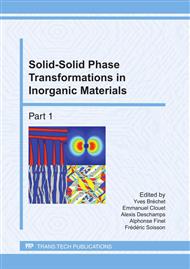p.511
p.517
p.525
p.539
p.549
p.555
p.561
p.567
p.573
On the Effect of Bulk Diffusion on the Initiation of the Discontinuous Precipitation Reaction: Phase-Field Simulations
Abstract:
Discontinuous precipitation is a solid-state transformation involving the decomposition of a supersaturated matrix into two phases arranged periodically as alternate lamellae or rods, which is accompanied by a grain boundary migration. The rate-limiting step of this process is supposed to be boundary diffusion of solute along grain boundaries. However, volume diffusion is generally present as well, and its influence on the occurrence of the discontinuous precipitation reaction is at present not well understood. We investigate this problem using a phase-field model in which the bulk diffusivity, surface diffusivity and grain boundary mobility can all be varied independently. The main results are that (i) when volume diffusion is the dominant mechanism, a close analogy is observed between the precipitate growth and the growth of a crystalline finger in a channel, and (ii) both the geometry of the precipitate’s tip and the growth velocity are strongly influenced by the relative magnitudes of the bulk and surface diffusivities as well as by the grain boundary mobility. Steady-state growth is possible only for a finite range of precipitate spacings, which is limited for low spacings by a fold singularity and for large spacings by an oscillatory or a tip-splitting instability. The values of these limits are found to depend on the supersaturation as well as on the ratio of bulk and surface diffusivities.
Info:
Periodical:
Pages:
549-554
Citation:
Online since:
June 2011
Authors:
Price:
Сopyright:
© 2011 Trans Tech Publications Ltd. All Rights Reserved
Share:
Citation:


